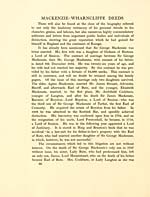Download files
Complete book:
Individual page:
Thumbnail gallery: Grid view | List view

MACKENZIE-WHARNCLIFFE DEEDS
called, who had then become Lady Mackenzie, had by her first husband
an only son, and on her brother's death she was pregnant by her second
husband. At this stage Lord Mountstuart purchased a brieve from
Chancery for having himself served heir of taillie and provision to his
grandfather, Sir George Mackenzie. This service was opposed by
Lady Langton and her husband, Sir James Mackenzie, upon the
ground that her son was preferable to Lady Bute's eldest or only
son, and that, therefore, Lord Mountstuart could not be served until
it were seen whether Lady Langton was to give birth to a second
son or not. In January 1708 the Court of Session unanimously found
that Lord Mountstuart was entitled to proceed with his service to
his grandfather. Lady Langton having soon thereafter given birth
to a second son — another George Mackenzie — an action was raised at
the child's instance with the concurrence of his father, Lord Royston,
for the purpose of reducing Lord Mountstuart 's service, and compel-
ling him to denude in favour of his youthful cousin. Whereupon
Lord Mountstuart instituted a new process of Declarator to support
his own service and rights. On the 13th December 1709 the Court
reduced Lord Mountstuart's service, and ordained him to denude in
favour of the child. This judgment was appealed, and while the
appeal was under consideration Lady Langton's elder son died in
London, and she being left with an only son, a new petition was pre-
sented by Lord Mountstuart founding on the altered circumstances,
the whole proceedings terminating with Lord Mountstuart's service
and title being upheld by the Court. It is seldom, indeed, that a
birth and a death occurring during the progress of a lawsuit so
completely changes the position of two families, and transfers from
one to another and then from the latter to the former a great landed
estate. Lord Royston died in Edinburgh on the 9th November
1744, aged seventy-three. He was buried in Sir George Mackenzie's
tomb. He is said to have been ' a person of vast learning, honour,
and probity, impartial in judgment, justly ranked among the first
judges in criminal causes of the age, and in private life a most
polite, friendly, agreeable, facetious, and affable gentleman.' There
is in the Advocates' Library in Edinburgh a copy of Sir George
37
called, who had then become Lady Mackenzie, had by her first husband
an only son, and on her brother's death she was pregnant by her second
husband. At this stage Lord Mountstuart purchased a brieve from
Chancery for having himself served heir of taillie and provision to his
grandfather, Sir George Mackenzie. This service was opposed by
Lady Langton and her husband, Sir James Mackenzie, upon the
ground that her son was preferable to Lady Bute's eldest or only
son, and that, therefore, Lord Mountstuart could not be served until
it were seen whether Lady Langton was to give birth to a second
son or not. In January 1708 the Court of Session unanimously found
that Lord Mountstuart was entitled to proceed with his service to
his grandfather. Lady Langton having soon thereafter given birth
to a second son — another George Mackenzie — an action was raised at
the child's instance with the concurrence of his father, Lord Royston,
for the purpose of reducing Lord Mountstuart 's service, and compel-
ling him to denude in favour of his youthful cousin. Whereupon
Lord Mountstuart instituted a new process of Declarator to support
his own service and rights. On the 13th December 1709 the Court
reduced Lord Mountstuart's service, and ordained him to denude in
favour of the child. This judgment was appealed, and while the
appeal was under consideration Lady Langton's elder son died in
London, and she being left with an only son, a new petition was pre-
sented by Lord Mountstuart founding on the altered circumstances,
the whole proceedings terminating with Lord Mountstuart's service
and title being upheld by the Court. It is seldom, indeed, that a
birth and a death occurring during the progress of a lawsuit so
completely changes the position of two families, and transfers from
one to another and then from the latter to the former a great landed
estate. Lord Royston died in Edinburgh on the 9th November
1744, aged seventy-three. He was buried in Sir George Mackenzie's
tomb. He is said to have been ' a person of vast learning, honour,
and probity, impartial in judgment, justly ranked among the first
judges in criminal causes of the age, and in private life a most
polite, friendly, agreeable, facetious, and affable gentleman.' There
is in the Advocates' Library in Edinburgh a copy of Sir George
37
Set display mode to:
![]() Universal Viewer |
Universal Viewer | ![]() Mirador |
Large image | Transcription
Mirador |
Large image | Transcription
Images and transcriptions on this page, including medium image downloads, may be used under the Creative Commons Attribution 4.0 International Licence unless otherwise stated. ![]()
| Histories of Scottish families > Ancient deeds and other writs in the Mackenzie-Wharncliffe charter-chest > (59) Page 37 |
|---|
| Permanent URL | https://digital.nls.uk/95524073 |
|---|
| Description | A selection of almost 400 printed items relating to the history of Scottish families, mostly dating from the 19th and early 20th centuries. Includes memoirs, genealogies and clan histories, with a few produced by emigrant families. The earliest family history goes back to AD 916. |
|---|

